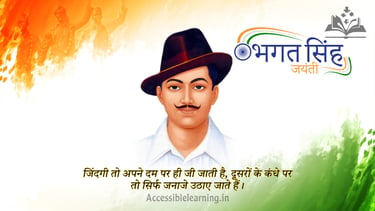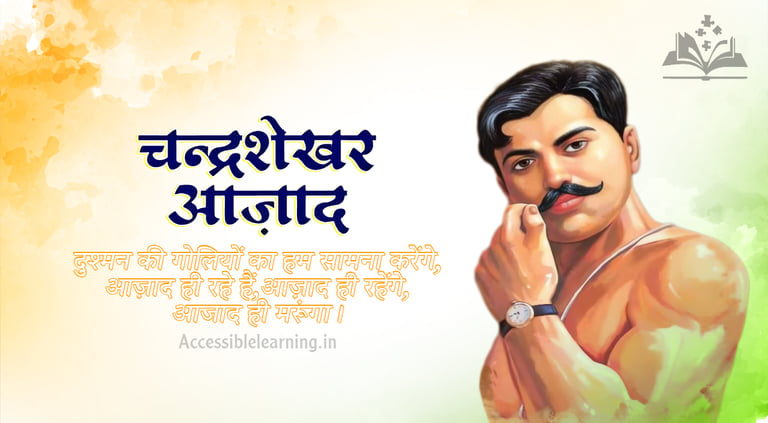
The Life, Struggle, and Sacrifice of Bhagat Singh: A Hero for the Ages
Learn about the life and legacy of Bhagat Singh, a revolutionary icon in India's fight for independence. Learn about his courageous struggle, intellectual contributions, and ultimate sacrifice that will continue to inspire generations.
INDIAN HISTORYTHE GREAT LEADEREMPIRES/HISTORYBIOGRAPHY/HISTORYBIOGRAPHY
Sachin K Chaurasiya
9/14/20243 min read


Bhagat Singh Ji (भगत सिंह जी), a name synonymous with courage and sacrifice, played a key role in India's freedom struggle. His revolutionary spirit, intellectual contributions, and supreme sacrifice have immortalized him as a national hero. This article delves into his life in more depth, including his early years, revolutionary activities, trials, and lasting legacy.
Formative Years & Early Influences!
Bhagat Singh Ji's (भगत सिंह जी) early life was marked by his family's deep involvement in the independence movement. His father, Kishan Singh Sandhu Ji (किशन सिंह संधू जी), and his uncle, Ajit Singh Ji (अजीत सिंह जी), were prominent figures in the struggle against British colonial rule. The socio-political environment of early 20th-century India, characterized by British repression and widespread discontent, deeply influenced Bhagat Singh's worldview.
From an early age, Bhagat Singh Ji was exposed to nationalist ideas through his family's political activities and stories of freedom fighters. His education at D.A.V. School in Lahore and later at National College further shaped his ideological beliefs. His admiration for the revolutionary leaders of the time and exposure to nationalist literature fueled his desire to actively participate in the struggle for independence.
Joining the Revolutionary Movement
In 1926, Bhagat Singh Ji joined the Hindustan Socialist Republican Association (HSRA), a revolutionary organization committed to armed struggle against British rule. Under the influence of leaders such as Chandrashekhar Azad Ji (चंद्रशेखर आज़ाद जी) and Ram Prasad Bismil Ji (राम प्रसाद बिस्मिल जी), Bhagat Singh became a prominent figure in the organization. His involvement in the HSRA marked a significant shift from a moderate to a radical approach in the struggle for independence. Bhagat Singh Ji's commitment to the revolutionary cause was evident in his meticulous planning and execution of key activities. The assassination of John Saunders in 1928 was a strategic move aimed at avenging the death of Lala Lajpat Rai, who died as a result of police brutality. This act of defiance brought Bhagat Singh and his colleagues into the national spotlight.
The Assembly Bombing & Trial!
On April 8, 1929, Bhagat Singh Ji (भगत सिंह जी) and Batukeshwar Dutt Ji (बटुकेश्वर दत्त जी) threw two non-lethal bombs into the Central Legislative Assembly in Delhi. The aim was to protest repressive laws and draw attention to their revolutionary cause without causing any harm. The bombs were intended to send a loud message rather than cause casualties.
After their arrest, Bhagat Singh and Dutt used their trial as a platform to advocate their revolutionary ideals. They used the courtroom to highlight the injustices of British rule and call for a more radical approach to achieving independence. Their trial attracted significant public attention and support, making them symbols of resistance against British colonialism.
Intellectual Contributions & Writings!
During his imprisonment, Bhagat Singh Ji remained an influential voice in the revolutionary movement. He wrote extensively on a variety of topics, including socialism, nationalism, and the role of youth in political activism. His essays, such as "Why I am an Atheist (मैं नास्तिक क्यों हूँ?)" and "The Revolutionary Movement in India (भारत में क्रांतिकारी आंदोलन)," reflect his deep understanding of political philosophy and his vision for an independent India.
Bhagat Singh Ji's writings not only expressed his revolutionary ideas but also attempted to inspire and organize the youth. His views on the need for radical change and social justice resonated with many, further cementing his role as a thought leader in the independence movement.
The Execution & National Impact!
Bhagat Singh Ji (भगत सिंह जी), Rajguru Ji (राजगुरु जी), and Sukhdev Ji (सुखदेव जी) were sentenced to death for the murder of John Saunders and involvement in other revolutionary activities. Despite widespread protests and appeals for clemency, the British government hanged them on March 23, 1931. They were hanged in Lahore Central Jail, and it sparked outrage and grief across the country.
The martyrdom of Bhagat Singh and his comrades became a rallying point for the Indian independence movement. Their sacrifice was seen as proof of the ultimate price of freedom, and their legacy continues to inspire future generations of freedom fighters and activists.
Enduring Legacy & Commemoration!
Bhagat Singh Ji's legacy extends far beyond his revolutionary activities and martyrdom. He is remembered as a symbol of youthful idealism, courage, and uncompromising commitment to the cause of freedom. Numerous schools, colleges, and public spaces across India are named in his honor, and his life and work continue to be celebrated through literature, films, and educational programs.
The impact of Bhagat Singh Ji's life is also reflected in the way he is revered in contemporary Indian society. His story is taught in schools as an example of patriotism and sacrifice, and his writings are studied for their political and philosophical insights.
Bhagat Singh Ji's (भगत सिंह जी) life is a powerful tale of struggle, sacrifice, and dedication. His revolutionary activities, intellectual contributions, and ultimate martyrdom have left an indelible mark on India's history. When we reflect on his legacy, we honor not only a courageous freedom fighter but also a visionary who dared to dream of a better, freer India. Bhagat Singh Ji's story remains a beacon of inspiration, reminding us of the enduring values of courage, commitment, and the relentless pursuit of justice.
Subscribe to our newsletter
All © Copyright reserved by Accessible-Learning
| Terms & Conditions
Knowledge is power. Learn with Us. 📚




